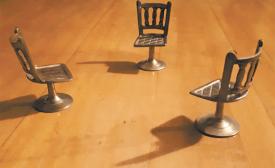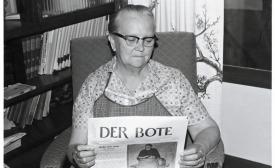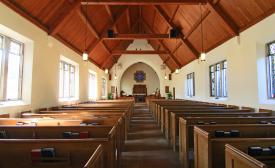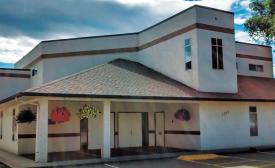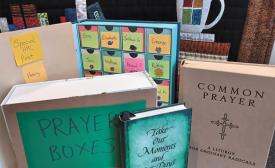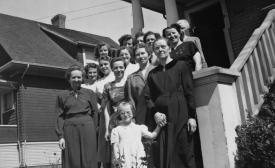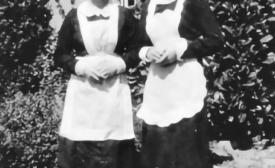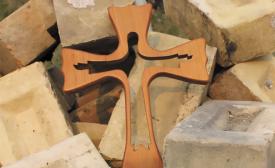Volume 25, Number 17
Moving toward normal
The COVID-19 coronavirus will be with us for a while; that’s what the health experts are saying. What does this mean for our churches and communities?
Three chairs: In, out and up
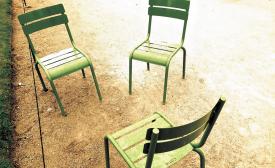
One of the three chairs represents the directee, or client, who is seeking support on their spiritual journey. The second chair represents the spiritual director—the one who is listening in three directions: Out, to their client; up to God; in, to notice their own responses. The third chair is a reminder that the real spiritual director is the Holy Spirit. (Photo by Ralph Brubacher)
When I was taking part in the Ontario Jubilee program in soul care and spiritual direction, one of the principles that guided our time together was that everything we did as a whole group happened in a circle.
Readers write: August 16, 2021 issue
‘Big’ farmers can be ‘Christians with a conscience’ too
Re: “Germinating conversations,” June 7, page 16.
Why don’t we talk about evangelism?
He discretely looked to the left, then to the right and said quietly, “Why don’t we talk about evangelism in this denomination?”
I grinned and replied, “Ever seen the movie A Thief in the Night?”
“No”, he said.
I briefly described the 1970s era Christian film depicting a rapture, tribulation and the second coming of Christ.
Der Bote 1924
The German-language periodical Der Bote was begun in Rosthern, Sask., in 1924, to connect Mennonites in Russia, Canada, the United States and Latin America. It had generations of faithful readers, like Mrs. Lepp, pictured. Der Bote recorded the pain and loss of home and loved ones. It provided advice on how to improve farming practices in times of drought.
What will church look like?
Church is not the building. We’ve heard that often over the last 18 months. But now that some congregations are back in their building, with the rest trying to figure it out, I wonder who will come back? And what will we come back to?
I have heard a variety of opinions around me, which may be a microcosm of many of our congregations.
It’s about to get weird
I was about to take a shower, and for some reason, I looked at myself in the mirror. Rookie mistake. You see, I’ve gained 5.5 kilograms in the last year and, without access to my local gym and trainer for the past 13 months, I’ve lost some muscle mass.
Fires, COVID-19 affect Kelowna residents
Between fires and a COVID-19 outbreak, residents of Kelowna, B.C., including members of First Mennonite Church, have been doubly hit this summer.
Gutter cleaning fundraiser for Wi-Fi boosters
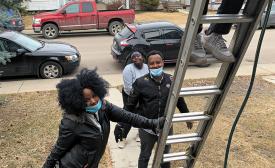
Florence Irasubiza of the Democratic Republic of Congo, left, and Helena Chokpelleh, a Liberian who attends Holyrood Mennonite Church in Edmonton, clean gutters as a fundraiser to buy Wi-Fi boosters for low-income newcomer families. Community connector Emmanuel Mbonimpa is in front of the ladder. (Photo by Joanne De Jong)

Helena Chokpelleh of Holyrood Mennonite Church, left, and Goanar Tut of South Sudanese Mennonite Church, hold up the certificates they received in July 2021 after completing the Civic Engagement by Newcomer Youth program at the Edmonton Mennonite Centre for Newcomers. Tut’s dog is named “Scottie.” (Photo by Joanne De Jong)
Two Mennonite high school students from African countries were interviewed and accepted into the Civic Engagement by Newcomer Youth program last fall through the Edmonton Mennonite Centre for Newcomers. One of the requirements for the participants is to identify a problem or issue in the community they care about and come up with a plan to address that issue in some way.
Staying strong
At a time when many churches are dealing with declining numbers in their pews, Hamilton (Ont.) Mennonite Church has grown. Membership in 1965 was 28; before the pandemic attendances averaged about 70 each Sunday; then, in 2020, attendance more than doubled.
Plaque honours Mennonite maids of Vancouver
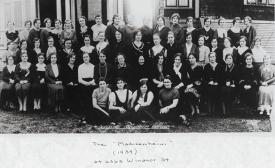
Young Mennonite women served as domestics to help their families repay debt. (Photo courtesy of Ruth Derksen Siemens)

A group of young women from the earliest Mennonite Brethren Girls’ Home (Bethel Home). (Photo courtesy of Ruth Derksen Siemens)
A new plaque honours the young Mennonite women who worked as domestic help in Vancouver in the mid-20th century.
An initiative of The Places That Matter, this is No. 89 of 125 commemorations erected by the Vancouver Heritage Foundation plaque project, launched in 2011 with a grant from the Government of Canada’s Celebrate Vancouver 125.
Renewing life on the stage
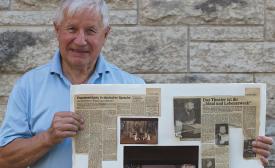
Henry Schroeder, chair of the Winnipeg Mennonite Theatre board, began acting with the troupe in 1974. ‘Our productions these days are much more modest efforts, but the creative energy and the love of theatre are still there,” he says. (Photo by Nicolien Klassen-Wiebe)
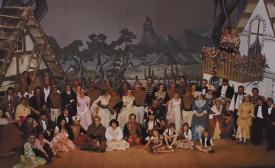
The Winnipeg Mennonite Theatre cast on the set of Der Zigeunerbaron (The Gypsy Baron) presented in 1979 at the Pantages Playhouse Theatre, which, at that time, seated more than 1,600 people. On opening night, the box office had to put up the SRO (sold right out) sign. (Photo by Nicolien Klassen-Wiebe)
Mennonites are sometimes associated with their four-part harmony rather than their acting, but one group has been making a name for Mennonites in the theatre for decades. Winnipeg Mennonite Theatre, a not-for-profit amateur community theatre company, is celebrating its 50th anniversary in 2022.
Three churches navigate the loss of meeting space
Church is not made of bricks and mortar, but for most congregations—not all—a building is integral. Congregations that lose their building face big questions about identity and the essentials of church life. I spoke with two congregations that have gone through the process recently and one that is in the thick of it.
British Columbia
A planter of seeds of good news
Three months after a cancer diagnosis, Erwin H. Rempel, 76, died June 25, at Virginia Mennonite Retirement Community in Harrisonburg, Va. Erwin and Angela, his wife of 55 years, served with Mennonite Mission Network and a predecessor agency, the Commission on Overseas Mission (COM), on four continents, from 1975 to 2009.


